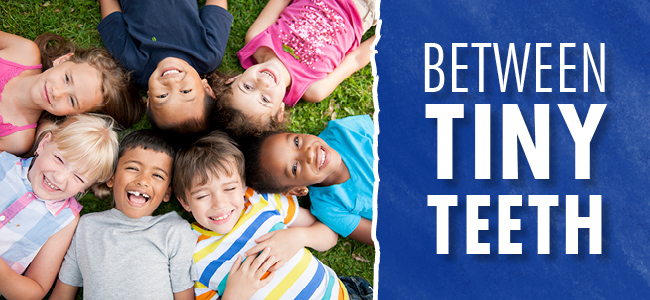By admin
15 Jun, 2016
Dental Health, Dental Tips, General Dentistry, General Health, Lifestyle, Oral Health
brushing, children's dentistry, flossing, oral hygiene, pediatric dentistry

Even though baby’s first teeth are temporary, getting an early start on excellent dental hygiene practices, including both brushing and flossing, is essential to a lifetime of good oral health. Dental decay is one of the most common childhood diseases. According to the Centers for Disease Control and Prevention (CDC), 42% of children ages 2 to 11 have had cavities in baby teeth, and 21% of those ages 6 to 11 have had cavities in permanent teeth.
Tooth decay not only poses a threat to tiny teeth, it can negatively affect a child’s whole health, as well as how they feel about themselves. One of the longest-lasting benefits of a healthy smile during childhood is the foundation for a healthy self-image.
Start Early
Brushing
You should begin cleaning a baby’s gums after each feeding with gauze or a soft cloth starting immediately after birth. As soon as the baby teeth begin to erupt, you can use a soft-bristled child’s toothbrush to clean your toddler’s teeth. Continue brushing for them until they have the dexterity to take over (approximately around 6 years old).
Flossing
Flossing is difficult for small, untrained hands. Your child doesn’t have to begin brushing right away, but once their tooth surfaces are almost touching, plaque and food begin to settle in between teeth, which can lead to gum disease and tooth decay. At this point, they should begin learning to floss and doing so at least once a day.
Teaching your child to floss can be tricky. The following steps will help you get them off to an easy start.
- Choose soft, flavored floss that’s gentle on your child’s gums and tastes good.
- Measure out a length of floss that runs from your fingers to your elbow.
- Wrap the floss around your child’s fingers as you would your own when flossing, but make sure it isn’t so tight that it cuts off circulation or causes any discomfort.
- Gently guide your children’s fingers, and show them how to glide the floss between the teeth.
- Show them how to make the floss into a C shape and curve it carefully beneath the gum line.
- Make sure they shift the floss to the next finger between each tooth so that they use fresh floss in each space.
At first flossing may be difficult and even frustrating for your little one. They may not like wrapping the string around their fingers, or they may just find changing the wrap of the floss too difficult. Fortunately, there are a wide variety of child-friendly floss sticks available in different colors and flavors. They come in packs of 50 to 100, giving your little one room for error. Make sure they dispose of each floss stick after use.
If your child is having an extra difficult time learning to floss, or if they have braces, consider trying the Waterpik Water Flosser for Kids. It’s made with a simple design that makes flossing easy for children over the age of 6. It is child safe and designed for small hands, so that your child’s frustration will be alleviated and their teeth will get cleaned properly.
As your children develop, they will be able to execute flossing with ease and can decide whether to continue using their flossing stick or a Waterpik, or whether to take the more traditional route.
For more information and help educating your child on the importance of their oral hygiene practices, call us today. We prepare you with information and instructions on how to clean your child’s teeth, as well as how to teach your child to clean their own teeth — or we can teach them with you.
More
By admin
08 Feb, 2016
Dental Health, Dental Tips, General Dentistry, Lifestyle
children's dentistry, dental health, gifts, healthy smile, pediatric dentistry, tooth-friendly treats, toothbrush, valentine's day

Nothing Is Sweeter Than a Healthy Smile
Valentine’s Day is a holiday that can leave many parents feeling conflicted. Anything that gives you an excuse to spoil your kiddos with gifts and tell them how much you love them is a welcome retreat from the daily grind of handing out chores and pushing through homework. One daily parenting task that commonly elicits dread is convincing your children to brush their teeth. Every parent knows how important their children’s oral health is, and instilling solid early oral hygiene practices so that your kids can enjoy a lifetime of healthy smiles is even more important. Thus the downside of Valentine’s Day: all the sugary treats.
Valentine’s Day is almost as notorious a threat to your kids’ teeth as Halloween. They inevitably come home from their classroom celebrations with paper bags full of chocolate and handfuls of candies with messages of love written on them. While these lovely confections please your kids, they are anxiety inducing when you catch yourself considering the damage being done to your children’s tiny pearly whites.
That’s not to mention the difficulty you face when trying to figure out gifts to give them and Valentines they can give to their friends and classmates that won’t cause cavities. While you can’t control what they will be bringing home, you can skip on contributing to acts of love that promote decay. Below we have put together four DIY, tooth-healthy Valentine’s Day gift ideas that show love while also producing happy, healthy smiles.
“You Make Me Smile” Toothbrush Valentine (Adapted from Time 2 Save Time 2 Give): This Valentine is simple to make and sends a sweet message while promoting good oral hygiene habits. You will need child-friendly toothbrushes, ribbon, colored paper, and a marker. Simply cut small hearts out of the paper and write a Valentine’s Day message like “You Make Me Smile” on each one. Attach ribbon to the back of the heart with tape and tie it to a toothbrush (still in package). You children’s classmates won’t be the only ones grinning! You can bet their parents will be feeling the love too.
Paper Airplane Valentine Free Printable (From NoBiggie.net): NoBiggie.net offers a free customizable, printable airplane Valentine that is perfect for the future pilots in your family. It’s quick and easy to make with corresponding numbers to help guide your way, and there’s even a video tutorial to walk you through creating the airplanes, making this a great last-minute go-to if you’ve been procrastinating.
I’m Nuts About You Treat Bag Printable (From Design Dining Diapers): If your children just have to hand out yummy treats, bags of peanuts are perfect. This tooth-friendly treat is low in sugar and high in protein, and if you go to the Design Dining Diapers site and follow the instructions, you can download a printable tag that says “I’m Nuts About You” and use it to fasten shut your baggie full of peanuts, leaving your children with a fun, yummy Valentine to hand out to friends.
Lunchtime Love: Show your children how much you love them with a little lunchtime love. You can give your children yummy hearts that aren’t made out of chocolate. Most kitchen-supply stores carry stainless-steel sandwich cutters in a variety of shapes and sizes. Use heart-shaped cutters to turn a turkey sandwich in a friendly reminder that you care. Smaller cutters can be used for meat and cheese slices or to turn slices of melon into a juicy, red dessert.
Valentine’s Day doesn’t have to lead to decay; there are plenty of candy-less ways to celebrate love. If your children come home with bags full of sugary goodies, make sure they brush their teeth after every treat — and then call us to book an appointment for a cleaning.
Happy Valentine’s Day from all of the staff at Douglas B. Weber, DDS!
More


